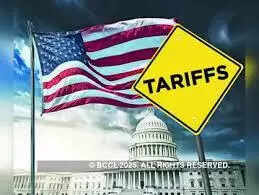- Policy
- 3 min read
From pharma to auto: How will US tariff hike impact different sectors in India?
The tariff hike covers several major export sectors, including electronics, textiles, pharmaceuticals, gems and jewellery, agricultural products, chemicals, and automobiles and parts. However, pharmaceuticals have been exempt from the new tariffs for now.
India's merchandise exports to the US could face a mixed impact as the US has raised average import tariffs on Indian goods to 26% from 3.5%, under a new reciprocal tariff framework. This move comes amid an overall trade surplus for India with the US in FY24, with exports at $77.5 billion compared to imports worth $42.2 billion.
The tariff hike covers several major export sectors, including electronics, textiles, pharmaceuticals, gems and jewellery, agricultural products, chemicals, and automobiles and parts, according to a CareEdge Ratings report. However, pharmaceuticals have been exempt from the new tariffs for now.
While the immediate impact varies by sector, the tariff burden is expected to be neutral for most, including electronics, textiles, agricultural products, chemicals, and automobiles and parts. The gems and jewellery segment is likely to be adversely affected due to the discretionary nature of demand and ongoing pressure from lab-grown diamonds.
India is comparatively better placed than other key competing nations, as the reciprocal tariffs imposed on exports from Vietnam (46%), Bangladesh (37%), China (34%), Taiwan (32%), Indonesia (32%), and Pakistan (29%) are significantly higher. This may offer Indian exporters a relative edge in some sectors.
Sector-wise analysis
Electronics: While the US tariffs could impact demand and pricing, higher reciprocal tariffs on China may result in a neutral impact for Indian electronics exports. Still, the limited value addition in smartphones—India’s key electronics export—could see some manufacturing shift to the US, posing a downside risk.
Textiles: With higher tariffs imposed on competing countries like China, Vietnam, and Bangladesh, India’s cotton-dominated textile exports are expected to weather the hike better. India’s self-sufficiency in cotton adds to its resilience.
Pharmaceuticals: The sector remains unaffected for now, being exempt from reciprocal tariffs. Even if included later, India’s strong position in US FDA-approved facilities and dominance in generics would allow it to absorb or pass on higher costs.
Gems and jewellery: This segment faces the sharpest downside, with tariffs rising from 3.17% to 26%. As a luxury product already under pricing pressure due to competition from lab-grown diamonds, demand is likely to be hit.
Agricultural products: While tariffs on Indian exports have risen to 26% from 5.3%, the increase is offset by even higher tariffs on other key exporting nations. However, Ecuador’s lower 10% tariff could pressure Indian shrimp exports in particular.
Chemicals: With India’s chemical exports to the US being relatively small, the overall impact is minimal. Nonetheless, high tariffs on Chinese chemical exports may benefit some Indian exporters. However, concerns remain about potential dumping by China in India and other global markets.
Automobiles and parts: Given the low volume of exports to the US, the direct impact is expected to be limited. Indian auto component suppliers remain critical for US OEMs, giving them time to adjust and possibly shielding them from short-term disruptions.
Despite sectoral challenges, India's relative tariff positioning could provide an advantage in global competitiveness. However, the possibility of dumping by nations facing higher US tariffs remains a risk to monitor, especially in sectors like chemicals.







COMMENTS
All Comments
By commenting, you agree to the Prohibited Content Policy
PostBy commenting, you agree to the Prohibited Content Policy
Post